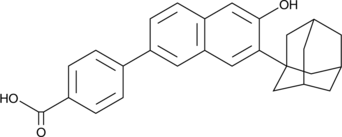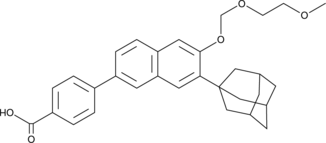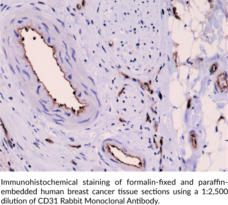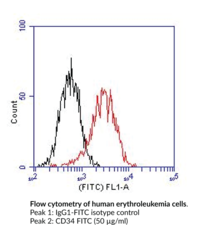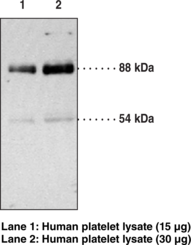Cayman
Showing 14401–14550 of 45550 results
-
CCT241161 is a multi-kinase inhibitor that inhibits B-RAF, B-RAFV600E, C-RAF, Src, and LCK (IC50s = 252, 15, 6, 15, and 3 nM, respectively).{41909} It is selective for RAFs, Src, LCK, and MAPKs in a panel of 63 kinases when used at a concentration of 1 µM. CCT241161 inhibits MEK and ERK signaling in B-RAF mutant WM266.4 cells, but not B-RAF wild-type D35 cells, and inhibits growth of B-RAF mutant melanoma cells in a concentration-dependent manner. In vivo, CCT241161 (20 mg/kg per day) induces tumor regression in a B-RAF mutant A375 mouse xenograft model. CCT241161 also inhibits ERK and Src signaling and induces tumor regression in B-RAF inhibitor-resistant patient-derived xenograft (PDX) mouse models including those resistant to both dabrafenib (Item No. 16989) and trametinib (Item No. 16292).
Brand:CaymanSKU:25536 - 1 mgAvailable on backorder
CCT241161 is a multi-kinase inhibitor that inhibits B-RAF, B-RAFV600E, C-RAF, Src, and LCK (IC50s = 252, 15, 6, 15, and 3 nM, respectively).{41909} It is selective for RAFs, Src, LCK, and MAPKs in a panel of 63 kinases when used at a concentration of 1 µM. CCT241161 inhibits MEK and ERK signaling in B-RAF mutant WM266.4 cells, but not B-RAF wild-type D35 cells, and inhibits growth of B-RAF mutant melanoma cells in a concentration-dependent manner. In vivo, CCT241161 (20 mg/kg per day) induces tumor regression in a B-RAF mutant A375 mouse xenograft model. CCT241161 also inhibits ERK and Src signaling and induces tumor regression in B-RAF inhibitor-resistant patient-derived xenograft (PDX) mouse models including those resistant to both dabrafenib (Item No. 16989) and trametinib (Item No. 16292).
Brand:CaymanSKU:25536 - 10 mgAvailable on backorder
CCT241161 is a multi-kinase inhibitor that inhibits B-RAF, B-RAFV600E, C-RAF, Src, and LCK (IC50s = 252, 15, 6, 15, and 3 nM, respectively).{41909} It is selective for RAFs, Src, LCK, and MAPKs in a panel of 63 kinases when used at a concentration of 1 µM. CCT241161 inhibits MEK and ERK signaling in B-RAF mutant WM266.4 cells, but not B-RAF wild-type D35 cells, and inhibits growth of B-RAF mutant melanoma cells in a concentration-dependent manner. In vivo, CCT241161 (20 mg/kg per day) induces tumor regression in a B-RAF mutant A375 mouse xenograft model. CCT241161 also inhibits ERK and Src signaling and induces tumor regression in B-RAF inhibitor-resistant patient-derived xenograft (PDX) mouse models including those resistant to both dabrafenib (Item No. 16989) and trametinib (Item No. 16292).
Brand:CaymanSKU:25536 - 5 mgAvailable on backorder
CCT241161 is a multi-kinase inhibitor that inhibits B-RAF, B-RAFV600E, C-RAF, Src, and LCK (IC50s = 252, 15, 6, 15, and 3 nM, respectively).{41909} It is selective for RAFs, Src, LCK, and MAPKs in a panel of 63 kinases when used at a concentration of 1 µM. CCT241161 inhibits MEK and ERK signaling in B-RAF mutant WM266.4 cells, but not B-RAF wild-type D35 cells, and inhibits growth of B-RAF mutant melanoma cells in a concentration-dependent manner. In vivo, CCT241161 (20 mg/kg per day) induces tumor regression in a B-RAF mutant A375 mouse xenograft model. CCT241161 also inhibits ERK and Src signaling and induces tumor regression in B-RAF inhibitor-resistant patient-derived xenograft (PDX) mouse models including those resistant to both dabrafenib (Item No. 16989) and trametinib (Item No. 16292).
Brand:CaymanSKU:25536 - 500 µgAvailable on backorder
CCT241533 is a selective inhibitor of checkpoint kinase 2 (Chk2; IC50 = 3 nM).{34692} In human cancer cell lines, CCT241533 blocks Chk2 activity and potentiates the cytotoxicity of the PARP inhibitors, rucaparib, AG-1447; (Item No. 15643) and olaparib (Item No. 10621).{34691}
Brand:CaymanSKU:-Available on backorder
CCT241533 is a selective inhibitor of checkpoint kinase 2 (Chk2; IC50 = 3 nM).{34692} In human cancer cell lines, CCT241533 blocks Chk2 activity and potentiates the cytotoxicity of the PARP inhibitors, rucaparib, AG-1447; (Item No. 15643) and olaparib (Item No. 10621).{34691}
Brand:CaymanSKU:-Available on backorder
CCT241533 is a selective inhibitor of checkpoint kinase 2 (Chk2; IC50 = 3 nM).{34692} In human cancer cell lines, CCT241533 blocks Chk2 activity and potentiates the cytotoxicity of the PARP inhibitors, rucaparib, AG-1447; (Item No. 15643) and olaparib (Item No. 10621).{34691}
Brand:CaymanSKU:-Available on backorder
CCT241533 is a selective inhibitor of checkpoint kinase 2 (Chk2; IC50 = 3 nM).{34692} In human cancer cell lines, CCT241533 blocks Chk2 activity and potentiates the cytotoxicity of the PARP inhibitors, rucaparib, AG-1447; (Item No. 15643) and olaparib (Item No. 10621).{34691}
Brand:CaymanSKU:-Available on backorder
CCT241736 is a dual inhibitor of Aurora kinases (Kds = 7.5 and 48 nM for Aurora A and B, respectively) and FLT3 (Kds = 6.2, 38, and 14 nM for wild-type, FLT3ITD, and FLT3D835Y, respectively).{27919} It also inhibits the activity of 22 additional kinases by greater than 90% in a panel of 386 nonmutant kinases at 1 µM. CCT241736 inhibits cell growth of SW620, HCT116, MOLM-13, and MV4-11 cancer cells (GI50s = 1, 0.3, 0.1, and 0.3 µM, respectively). Oral administration of CCT241736 (50 mg/kg twice per day) reduces tumor growth by 58% in an MV4-11 mouse xenograft model.
Brand:CaymanSKU:26185 - 10 mgAvailable on backorder
CCT241736 is a dual inhibitor of Aurora kinases (Kds = 7.5 and 48 nM for Aurora A and B, respectively) and FLT3 (Kds = 6.2, 38, and 14 nM for wild-type, FLT3ITD, and FLT3D835Y, respectively).{27919} It also inhibits the activity of 22 additional kinases by greater than 90% in a panel of 386 nonmutant kinases at 1 µM. CCT241736 inhibits cell growth of SW620, HCT116, MOLM-13, and MV4-11 cancer cells (GI50s = 1, 0.3, 0.1, and 0.3 µM, respectively). Oral administration of CCT241736 (50 mg/kg twice per day) reduces tumor growth by 58% in an MV4-11 mouse xenograft model.
Brand:CaymanSKU:26185 - 25 mgAvailable on backorder
CCT241736 is a dual inhibitor of Aurora kinases (Kds = 7.5 and 48 nM for Aurora A and B, respectively) and FLT3 (Kds = 6.2, 38, and 14 nM for wild-type, FLT3ITD, and FLT3D835Y, respectively).{27919} It also inhibits the activity of 22 additional kinases by greater than 90% in a panel of 386 nonmutant kinases at 1 µM. CCT241736 inhibits cell growth of SW620, HCT116, MOLM-13, and MV4-11 cancer cells (GI50s = 1, 0.3, 0.1, and 0.3 µM, respectively). Oral administration of CCT241736 (50 mg/kg twice per day) reduces tumor growth by 58% in an MV4-11 mouse xenograft model.
Brand:CaymanSKU:26185 - 5 mgAvailable on backorder
CCT241736 is a dual inhibitor of Aurora kinases (Kds = 7.5 and 48 nM for Aurora A and B, respectively) and FLT3 (Kds = 6.2, 38, and 14 nM for wild-type, FLT3ITD, and FLT3D835Y, respectively).{27919} It also inhibits the activity of 22 additional kinases by greater than 90% in a panel of 386 nonmutant kinases at 1 µM. CCT241736 inhibits cell growth of SW620, HCT116, MOLM-13, and MV4-11 cancer cells (GI50s = 1, 0.3, 0.1, and 0.3 µM, respectively). Oral administration of CCT241736 (50 mg/kg twice per day) reduces tumor growth by 58% in an MV4-11 mouse xenograft model.
Brand:CaymanSKU:26185 - 50 mgAvailable on backorder
CCT244747 is a potent inhibitor of checkpoint kinase 1 (Chk1; IC50 = 8 nM).{41934} It is selective for Chk1 over FLT3, Chk2, and CDK1 (IC50s = 600, >10,000, and >10,000 nM, respectively) as well as a panel of 121 additional kinases at a concentration of 10 μM. CCT244747 reverses cell cycle arrest at the G2/M phase induced by etoposide (Item No. 12092) and SN-38 (Item No. 15632) in HT-29 cells and gemcitabine (Item Nos. 11690 | 9003096) in SW620 cells, indicating cellular G2 checkpoint abrogation. It potentiates the genotoxicity of SN-38, gemcitabine, and etoposide in HT-29, SW620, MiaPaCa-2, and Calu-6 cells with potentiation index (PI) values ranging from 1.9-8.5, 2.6-12.2, 5-16, and 1.4-5.6, respectively. In vivo, CCT244747 (75 mg/kg), in combination with irinotecan (Item No. 14180) or gemcitabine, increases the delay of tumor growth in SW620 and Calu-6 mouse xenograft models, respectively.
Brand:CaymanSKU:25666 - 1 mgAvailable on backorder
CCT244747 is a potent inhibitor of checkpoint kinase 1 (Chk1; IC50 = 8 nM).{41934} It is selective for Chk1 over FLT3, Chk2, and CDK1 (IC50s = 600, >10,000, and >10,000 nM, respectively) as well as a panel of 121 additional kinases at a concentration of 10 μM. CCT244747 reverses cell cycle arrest at the G2/M phase induced by etoposide (Item No. 12092) and SN-38 (Item No. 15632) in HT-29 cells and gemcitabine (Item Nos. 11690 | 9003096) in SW620 cells, indicating cellular G2 checkpoint abrogation. It potentiates the genotoxicity of SN-38, gemcitabine, and etoposide in HT-29, SW620, MiaPaCa-2, and Calu-6 cells with potentiation index (PI) values ranging from 1.9-8.5, 2.6-12.2, 5-16, and 1.4-5.6, respectively. In vivo, CCT244747 (75 mg/kg), in combination with irinotecan (Item No. 14180) or gemcitabine, increases the delay of tumor growth in SW620 and Calu-6 mouse xenograft models, respectively.
Brand:CaymanSKU:25666 - 10 mgAvailable on backorder
CCT244747 is a potent inhibitor of checkpoint kinase 1 (Chk1; IC50 = 8 nM).{41934} It is selective for Chk1 over FLT3, Chk2, and CDK1 (IC50s = 600, >10,000, and >10,000 nM, respectively) as well as a panel of 121 additional kinases at a concentration of 10 μM. CCT244747 reverses cell cycle arrest at the G2/M phase induced by etoposide (Item No. 12092) and SN-38 (Item No. 15632) in HT-29 cells and gemcitabine (Item Nos. 11690 | 9003096) in SW620 cells, indicating cellular G2 checkpoint abrogation. It potentiates the genotoxicity of SN-38, gemcitabine, and etoposide in HT-29, SW620, MiaPaCa-2, and Calu-6 cells with potentiation index (PI) values ranging from 1.9-8.5, 2.6-12.2, 5-16, and 1.4-5.6, respectively. In vivo, CCT244747 (75 mg/kg), in combination with irinotecan (Item No. 14180) or gemcitabine, increases the delay of tumor growth in SW620 and Calu-6 mouse xenograft models, respectively.
Brand:CaymanSKU:25666 - 5 mgAvailable on backorder
CCT245737 is a potent inhibitor of checkpoint kinase 1 (Chk1; IC50 = 1.3 nM).{52107} It is selective for Chk1 over Chk2 (IC50 = 2,440 nM). CCT245737 inhibits G2 checkpoint arrest induced by etoposide (Item No. 12092) in HT-29 colon cancer cells (IC50 = 30 nM). In vivo, CCT245737 (300 mg/kg) inhibits Chk1 autophosphorylation induced by gemcitabine (Item No. 11690) in an SW620 colon cancer mouse xenograft model. It reduces tumor volume when administered alone or in combination with gemcitabine in an HT-29 mouse xenograft model. CCT245737 (150 mg/kg) reduces inguinal, brachial/axillary, and mesenteric lymph node weights in the Eμ-Myc driven transgenic mouse transplant model of lymph gland-infiltrating B cell lymphoma.{52106}
Brand:CaymanSKU:28775 - 10 mgAvailable on backorder
CCT245737 is a potent inhibitor of checkpoint kinase 1 (Chk1; IC50 = 1.3 nM).{52107} It is selective for Chk1 over Chk2 (IC50 = 2,440 nM). CCT245737 inhibits G2 checkpoint arrest induced by etoposide (Item No. 12092) in HT-29 colon cancer cells (IC50 = 30 nM). In vivo, CCT245737 (300 mg/kg) inhibits Chk1 autophosphorylation induced by gemcitabine (Item No. 11690) in an SW620 colon cancer mouse xenograft model. It reduces tumor volume when administered alone or in combination with gemcitabine in an HT-29 mouse xenograft model. CCT245737 (150 mg/kg) reduces inguinal, brachial/axillary, and mesenteric lymph node weights in the Eμ-Myc driven transgenic mouse transplant model of lymph gland-infiltrating B cell lymphoma.{52106}
Brand:CaymanSKU:28775 - 5 mgAvailable on backorder
CCT251236 is an inhibitor of transcription mediated by heat shock factor 1 (Hsf1) that binds to Pirin (Ki = 28 nM) and inhibits Hsf1-mediated induction of heat shock protein 27 (Hsp27) in U2OS cells (IC50 = 19 nM).{47525} It inhibits growth of SKOV3 ovarian carcinoma cells (GI50 = 1.1 nM). CCT251236 (20 mg/kg) reduces tumor volume in an SKOV3 mouse xenograft model.
Brand:CaymanSKU:27788 - 1 mgAvailable on backorder
CCT251236 is an inhibitor of transcription mediated by heat shock factor 1 (Hsf1) that binds to Pirin (Ki = 28 nM) and inhibits Hsf1-mediated induction of heat shock protein 27 (Hsp27) in U2OS cells (IC50 = 19 nM).{47525} It inhibits growth of SKOV3 ovarian carcinoma cells (GI50 = 1.1 nM). CCT251236 (20 mg/kg) reduces tumor volume in an SKOV3 mouse xenograft model.
Brand:CaymanSKU:27788 - 10 mgAvailable on backorder
CCT251236 is an inhibitor of transcription mediated by heat shock factor 1 (Hsf1) that binds to Pirin (Ki = 28 nM) and inhibits Hsf1-mediated induction of heat shock protein 27 (Hsp27) in U2OS cells (IC50 = 19 nM).{47525} It inhibits growth of SKOV3 ovarian carcinoma cells (GI50 = 1.1 nM). CCT251236 (20 mg/kg) reduces tumor volume in an SKOV3 mouse xenograft model.
Brand:CaymanSKU:27788 - 25 mgAvailable on backorder
CCT251236 is an inhibitor of transcription mediated by heat shock factor 1 (Hsf1) that binds to Pirin (Ki = 28 nM) and inhibits Hsf1-mediated induction of heat shock protein 27 (Hsp27) in U2OS cells (IC50 = 19 nM).{47525} It inhibits growth of SKOV3 ovarian carcinoma cells (GI50 = 1.1 nM). CCT251236 (20 mg/kg) reduces tumor volume in an SKOV3 mouse xenograft model.
Brand:CaymanSKU:27788 - 5 mgAvailable on backorder
CCT251545 is an orally bioavailable inhibitor of Wnt signaling (IC50 = 5 nM).{34178} It is a potent and selective inhibitor of the human mediator complex-associated protein kinases Cdk8 and Cdk19.{30162} Through its effects on Cdk8 and Cdk19, CCT251545 alters Wnt pathway-regulated gene expression.{30162} It reduces tumor growth in COLO 205 human colon cancer xenografts after oral dosing (70 mg/kg bid) and in Wnt-dependent tumors.{34178,30162}
Brand:CaymanSKU:-Available on backorder
CCT251545 is an orally bioavailable inhibitor of Wnt signaling (IC50 = 5 nM).{34178} It is a potent and selective inhibitor of the human mediator complex-associated protein kinases Cdk8 and Cdk19.{30162} Through its effects on Cdk8 and Cdk19, CCT251545 alters Wnt pathway-regulated gene expression.{30162} It reduces tumor growth in COLO 205 human colon cancer xenografts after oral dosing (70 mg/kg bid) and in Wnt-dependent tumors.{34178,30162}
Brand:CaymanSKU:-Available on backorder
CCT251545 is an orally bioavailable inhibitor of Wnt signaling (IC50 = 5 nM).{34178} It is a potent and selective inhibitor of the human mediator complex-associated protein kinases Cdk8 and Cdk19.{30162} Through its effects on Cdk8 and Cdk19, CCT251545 alters Wnt pathway-regulated gene expression.{30162} It reduces tumor growth in COLO 205 human colon cancer xenografts after oral dosing (70 mg/kg bid) and in Wnt-dependent tumors.{34178,30162}
Brand:CaymanSKU:-Available on backorder
Fluorescent molecular rotors are molecules whose fluorescence is inversely proportional to its intramolecular rotation.{28886} The intramolecular rotation of these probes, and hence their fluorescence, depends on the immediate microenvironment of the probe.{28886} As a result, fluorescent molecular rotors are used to evaluate changes in solution and membrane viscosity, polymerization or aggregation processes, and protein (un)folding.{28885,28888,28887} CCVJ is a fluorescent molecular rotor characterized by low background fluorescence, low fluorescence anisotropy, and good water solubility.{28886,28887,28884,28889} Moreover, CCVJ has large hydrophobic structures, allowing it to associate in a non-covalent manner with hydrophobic pockets in proteins in solution.{28886} CCVJ is broadly used to monitor changes in solution and molecular characteristics.{28886,28887,28884}
Brand:CaymanSKU:-Available on backorder
Fluorescent molecular rotors are molecules whose fluorescence is inversely proportional to its intramolecular rotation.{28886} The intramolecular rotation of these probes, and hence their fluorescence, depends on the immediate microenvironment of the probe.{28886} As a result, fluorescent molecular rotors are used to evaluate changes in solution and membrane viscosity, polymerization or aggregation processes, and protein (un)folding.{28885,28888,28887} CCVJ is a fluorescent molecular rotor characterized by low background fluorescence, low fluorescence anisotropy, and good water solubility.{28886,28887,28884,28889} Moreover, CCVJ has large hydrophobic structures, allowing it to associate in a non-covalent manner with hydrophobic pockets in proteins in solution.{28886} CCVJ is broadly used to monitor changes in solution and molecular characteristics.{28886,28887,28884}
Brand:CaymanSKU:-Available on backorder
Fluorescent molecular rotors are molecules whose fluorescence is inversely proportional to its intramolecular rotation.{28886} The intramolecular rotation of these probes, and hence their fluorescence, depends on the immediate microenvironment of the probe.{28886} As a result, fluorescent molecular rotors are used to evaluate changes in solution and membrane viscosity, polymerization or aggregation processes, and protein (un)folding.{28885,28888,28887} CCVJ is a fluorescent molecular rotor characterized by low background fluorescence, low fluorescence anisotropy, and good water solubility.{28886,28887,28884,28889} Moreover, CCVJ has large hydrophobic structures, allowing it to associate in a non-covalent manner with hydrophobic pockets in proteins in solution.{28886} CCVJ is broadly used to monitor changes in solution and molecular characteristics.{28886,28887,28884}
Brand:CaymanSKU:-Available on backorder
Immunogen: Synthetic peptide corresponding to the C-terminal region of human lgCD146 • Host: Rabbit • Species Reactivity: (+) Human • Cross Reactivity: (+) lgCD146 (-) shCD146, soluble CD146 • Applications: IHC, WB
Brand:CaymanSKU:32202- 100 µlAvailable on backorder
Immunogen: Synthetic peptide corresponding to the C-terminal region of human lgCD146 • Host: Rabbit • Species Reactivity: (+) Human • Cross Reactivity: (+) lgCD146 (-) shCD146, soluble CD146 • Applications: IHC, WB
Brand:CaymanSKU:32202- 100 µlCD146, also known as the melanoma cell adhesion molecule (MCAM), is an adhesion molecule and type 1 transmembrane glycoprotein with roles in vascular homeostasis, cell migration, and neuronal differentiation and is encoded by MCAM in humans.{58076,58077} It is comprised of a signal sequence, an extracellular domain containing five immunoglobulin-like (Ig-like) domains, a hydrophobic transmembrane domain, and a cytosolic domain composed of an ezrin, radixin, moesin (ERM) protein complex binding motif and a double leucine motif for epithelial basolateral targeting. Alternative splicing of MCAM produces two isoforms that differ in length of their cytosolic domain, CD146 short (shCD146) and CD146 long (lgCD146), that contain one or two protein kinase C (PKC) phosphorylation sites, respectively.{58078} LgCD146 is expressed on endothelial cells, smooth muscle cells (SMCs), and pericytes where it is localized to tight junctions, as well as in mononuclear cells, mesenchymal stromal cells, and trophoblasts.{58076} It induces stabilization of capillary-like structures in a Matrigel™ assay. Cayman’s CD146 Long Rabbit Monoclonal Antibody can be used for immunohistochemistry (IHC) and Western blot (WB) applications.
Brand:CaymanSKU:32202 - 100 µlAvailable on backorder
Host: mouse, clone IPO-3 · Cross Reactivity: (+) human CD150 · Application(s): FC, ICC, IHC (frozen sections), and IP; may also be used for receptor ligation experiments
Brand:CaymanSKU:10004804- 1 eaAvailable on backorder
Host: mouse, clone IPO-3 · Cross Reactivity: (+) human CD150 · Application(s): FC, ICC, IHC (frozen sections), and IP; may also be used for receptor ligation experiments
Brand:CaymanSKU:10004804- 1 eaRevealing the molecular signals involved in B and T cell activation is critical to the future discovery of therapeutics that can augment cell-mediated immune responses to disease.{12747,12749,12748} CD150 is a type I transmembrane glycoprotein that is involved in signal transduction of antigen specific responses in B and T cells. It is expressed by activated B cells isolated from tonsils and peripheral blood, B cells in germinal centers and mantle zone of lymph nodes, immature thymocytes, and CD45RO+CD45RA- subpopulation of T cells.{12746,12772} This antibody has been used to detect CD150 in neoplastic cells from diffuse large B-cell lymphoma, Hodgkin’s disease, hairy cell leukemia, and some tumors of ectodermal origin.{12771}
Brand:CaymanSKU:10004804 - 1 eaAvailable on backorder
CD1530 is a selective retinoic acid receptor (RARγ) agonist (Kds = 150, 1,500, and 2,750 nM for RARγ, RARβ, and RARα receptors, respectively).{24736} It demonstrates transcriptional activity at RARγ with an AC50 value of 1.8 nM.{24736} It has been used in combination with bexarotene (Item No. 11571), a retinoid X receptor agonist, to inhibit oral carcinogenesis induced by the carcinogen 4-nitroquinoline 1-oxide in a mouse model of human oral-cavity and esophageal squamous-cell carcinoma.{31184}
Brand:CaymanSKU:-Available on backorder
CD1530 is a selective retinoic acid receptor (RARγ) agonist (Kds = 150, 1,500, and 2,750 nM for RARγ, RARβ, and RARα receptors, respectively).{24736} It demonstrates transcriptional activity at RARγ with an AC50 value of 1.8 nM.{24736} It has been used in combination with bexarotene (Item No. 11571), a retinoid X receptor agonist, to inhibit oral carcinogenesis induced by the carcinogen 4-nitroquinoline 1-oxide in a mouse model of human oral-cavity and esophageal squamous-cell carcinoma.{31184}
Brand:CaymanSKU:-Available on backorder
CD1530 is a selective retinoic acid receptor (RARγ) agonist (Kds = 150, 1,500, and 2,750 nM for RARγ, RARβ, and RARα receptors, respectively).{24736} It demonstrates transcriptional activity at RARγ with an AC50 value of 1.8 nM.{24736} It has been used in combination with bexarotene (Item No. 11571), a retinoid X receptor agonist, to inhibit oral carcinogenesis induced by the carcinogen 4-nitroquinoline 1-oxide in a mouse model of human oral-cavity and esophageal squamous-cell carcinoma.{31184}
Brand:CaymanSKU:-Available on backorder
CD20 is a non-glycosylated protein encoded by MS4A1 in humans.{59585} It is comprised of four transmembrane domains, a single intracellular loop, and two extracellular loop domains with both the N and C-termini located in the cytosol. CD20 is a general B cell marker that is expressed from the late pre-B lymphocyte stage but is not expressed by pro-B lymphocytes and is lost in terminally differentiated plasma cells and plasmablasts. It forms supramolecular complexes with CD53, CD81, and CD82, as well as MHCII, CD40, B cell receptors, and C-terminal Src kinase-binding protein (CBP) to contribute to signal transduction. MS4A1 expression is variable in B cell malignancies, with the lowest expression found in patients with chronic lymphocytic leukemia (CLL) and the highest expression found in patients with diffuse large B cell lymphoma (DLBCL) or hairy cell lymphomas. MS4A1 expression is enriched on IFN-γ-inducible T-box transcription factor-expressing B cells in blood isolated from patients with multiple sclerosis.{59586} Cayman’s CD20 (C-Term) Rabbit Monoclonal Antibody can be used for immunohistochemistry (IHC) and Western blot (WB) applications.
Brand:CaymanSKU:32222 - 100 µlAvailable on backorder
Immunogen: Peptide from the C-terminal region of human CD20 • Host: Rabbit • Species Reactivity: (+) Human • Cross Reactivity: (+) CD20 • Applications: IHC, WB
Brand:CaymanSKU:32222- 100 µlAvailable on backorder
Immunogen: Peptide from the C-terminal region of human CD20 • Host: Rabbit • Species Reactivity: (+) Human • Cross Reactivity: (+) CD20 • Applications: IHC, WB
Brand:CaymanSKU:32222- 100 µlHost: Mouse, clone 143-13 • Applications: (+) FC, ICC, and IHC (frozen sections); (−) WB • Species reactivity: (+) Human CD25
Brand:CaymanSKU:10339- 1 eaInterleukin-2 (IL-2) elicits its effects by binding to a multi-subunit cell-surface receptor that is inducible by various mitogens.{18182,18183,18184} The highest affinity for IL-2 is achieved when all 3 subunits (IL-2Rα or CD25, IL-2Rβ or CD122, and IL-2Rγ or CD132) are expressed together forming a heterotrimeric complex{6128}. CD25 is inducible in T-cells by antigen, mitogen or antibodies bound to the T-cell receptor CD3.{18183,18185} Binding of IL-2 to IL-2R on NK cells results in their conversion to LAK cells, which release several other cytokines (TNF, INF-γ, and GM-CSF).{6128,6349} Activated T-cells will respond to IL-2 by proliferating and secreting cytokines and cytolytic molecules. Activated B cells will proliferate and secrete antibodies.{11282}
Brand:CaymanSKU:10339 - 1 eaAvailable on backorder
Host: Mouse, clone 143-13 • Applications: (+) FC, ICC, and IHC (frozen sections); (−) WB • Species reactivity: (+) Human CD25
Brand:CaymanSKU:10339- 1 eaAvailable on backorder
CD2665 is a selective retinoic acid receptor (RAR)β and RARγ antagonist (Kds = 110, 306, and > 2,250 nM for RARγ, RARβ, and RARα, respectively, with no binding at RXRα).{18516} At 10-7 M, it has been used to abrogate retinoic acid (Item No. 11017)-induced antiproliferative and antidifferentiative effects on sebocyte growth.{18516} This compound has been used in animal and in vitro cell models to explore the role of retinoid signaling in a number of biological processes including memory formation and tumor proliferation.{30066,30067}
Brand:CaymanSKU:-CD2665 is a selective retinoic acid receptor (RAR)β and RARγ antagonist (Kds = 110, 306, and > 2,250 nM for RARγ, RARβ, and RARα, respectively, with no binding at RXRα).{18516} At 10-7 M, it has been used to abrogate retinoic acid (Item No. 11017)-induced antiproliferative and antidifferentiative effects on sebocyte growth.{18516} This compound has been used in animal and in vitro cell models to explore the role of retinoid signaling in a number of biological processes including memory formation and tumor proliferation.{30066,30067}
Brand:CaymanSKU:-CD2665 is a selective retinoic acid receptor (RAR)β and RARγ antagonist (Kds = 110, 306, and > 2,250 nM for RARγ, RARβ, and RARα, respectively, with no binding at RXRα).{18516} At 10-7 M, it has been used to abrogate retinoic acid (Item No. 11017)-induced antiproliferative and antidifferentiative effects on sebocyte growth.{18516} This compound has been used in animal and in vitro cell models to explore the role of retinoid signaling in a number of biological processes including memory formation and tumor proliferation.{30066,30067}
Brand:CaymanSKU:-Host: mouse, clone 203.6 · Cross Reactivity: (+) human CD27 · Application(s): FC, ICC, and IHC (frozen sections); (−) WB
Brand:CaymanSKU:10004837- 1 eaAvailable on backorder
Host: mouse, clone 203.6 · Cross Reactivity: (+) human CD27 · Application(s): FC, ICC, and IHC (frozen sections); (−) WB
Brand:CaymanSKU:10004837- 1 eaCD27 is a type II homodimeric transmembrane glycoprotein (Mr = 55 kDa) and a member of the nerve growth factor/tumor necrosis receptor superfamily.{13302,13303} The antigen was identified on medullar thymocytes, mature T lymphocytes (CD45RA+CD45RO- T-cell subpopulation), memory B cells, plasma, and NK cells. This antibody is well suited for immunohistochemical detection of CD27 in B cell non-Hodgkin’s lymphoma samples.
Brand:CaymanSKU:10004837 - 1 eaAvailable on backorder
Host: mouse, clone RIV9 • Cross-Reactivity: (+) human; other species not tested • Application(s): (+) FC, IF, and IHC (frozen sections); (−) IHC (paraffin- embedded tissue) and WB
Brand:CaymanSKU:10231- 1 eaThe CD3 antigen is a specific T-cell marker expressed on thymocytes and mature T-lymphocytes. The CD3 complex contains CD3g (Mr = 26 kDa), CD3d (Mr = 21 kDa), and CD3e (Mr = 20 kDa).{16550} CD3 is detected on the surface membrane or in the cytoplasm of T-cells from peripheral blood, depending on the state of cell differentiation. In addition to detection of T-cells from peripheral blood, the CD3 antibody can be used for detection of reactive T-cells in lymphoid infiltrates in tissues and neoplastic T-cells in non-Hodgkin’s lymphomas of T-cell lineage.{12060,16551}
Brand:CaymanSKU:10231 - 1 eaAvailable on backorder
Host: mouse, clone RIV9 • Cross-Reactivity: (+) human; other species not tested • Application(s): (+) FC, IF, and IHC (frozen sections); (−) IHC (paraffin- embedded tissue) and WB
Brand:CaymanSKU:10231- 1 eaAvailable on backorder
Immunogen: Peptide corresponding to human CD31 cytoplasmic domain • Host: Rabbit • Species Reactivity: (+) Human • Cross Reactivity: (+) CD31 • Applications: IHC, WB • MW: ~130 kDa
Brand:CaymanSKU:32201- 100 µlAvailable on backorder
Immunogen: Peptide corresponding to human CD31 cytoplasmic domain • Host: Rabbit • Species Reactivity: (+) Human • Cross Reactivity: (+) CD31 • Applications: IHC, WB • MW: ~130 kDa
Brand:CaymanSKU:32201- 100 µlCD31, also known as platelet endothelial cell adhesion molecule (PECAM-1), is a vascular cell adhesion molecule and member of the immunoglobulin (Ig) superfamily of glycoproteins.{54427} It is a transmembrane glycoprotein that contains a large extracellular domain with Ig homology domains and glycosaminoglycan binding sites, a membrane-spanning region, and a cytoplasmic domain containing multiple phosphorylation sites.{54427,54428} CD31 is expressed on a variety of cells, including endothelial cells, monocytes, neutrophils, and platelets, among others.{54427} It forms homophilic interactions, which allow it to aggregate at endothelial cell-cell junctions where it regulates vascular permeability.{54428} Tyrosine phosphorylation at sites on the CD31 cytoplasmic domain, including at immunoreceptor tyrosine-based inhibitory motifs (ITIMs), recruits cytoplasmic proteins, leading to downstream signaling with either inhibitory or activating effects.{54429} CD31 also has roles in integrin-mediated adhesion, leukocyte recruitment, angiogenesis, and inflammation.{54428,54430,54431} High levels of CD31+ circulating cells positively correlate with C-reactive protein (CRP) levels and the Framingham risk score for hard coronary artery disease, while low levels on circulating cells negatively correlate with the Framingham risk score.{54432} A mutation in PECAM1, the gene encoding CD31, is associated with atherosclerotic cerebral infarction.{54433} Cayman’s CD31 Rabbit Monoclonal Antibody can be used for immunohistochemistry (IHC) and Western blot (WB) applications. The antibody recognizes CD31 at approximately 130 kDa from human samples.
Brand:CaymanSKU:32201 - 100 µlAvailable on backorder
CD3254 is a selective agonist of the retinoid X receptors (RXRs; EC50 = ~10 nM for human RXRβ) that is without effect on retinoic acid receptors (RARs).{28139,34373} It stimulates the recruitment of the nuclear receptor interaction domain of the TRAP220 coactivator to RXRα/RARβ heterodimers in vitro.{34374} CD3254 also enhances the recruitment of the PPARγ coactivator 1α, PGC-1α, to RXRα/PPARγ heterodimers.{28140}
Brand:CaymanSKU:20870 -Out of stock
CD3254 is a selective agonist of the retinoid X receptors (RXRs; EC50 = ~10 nM for human RXRβ) that is without effect on retinoic acid receptors (RARs).{28139,34373} It stimulates the recruitment of the nuclear receptor interaction domain of the TRAP220 coactivator to RXRα/RARβ heterodimers in vitro.{34374} CD3254 also enhances the recruitment of the PPARγ coactivator 1α, PGC-1α, to RXRα/PPARγ heterodimers.{28140}
Brand:CaymanSKU:20870 -Out of stock
CD3254 is a selective agonist of the retinoid X receptors (RXRs; EC50 = ~10 nM for human RXRβ) that is without effect on retinoic acid receptors (RARs).{28139,34373} It stimulates the recruitment of the nuclear receptor interaction domain of the TRAP220 coactivator to RXRα/RARβ heterodimers in vitro.{34374} CD3254 also enhances the recruitment of the PPARγ coactivator 1α, PGC-1α, to RXRα/PPARγ heterodimers.{28140}
Brand:CaymanSKU:20870 -Out of stock
Host: mouse, clone ICO-115 • Cross Reactivity: (+) human CD34 • Application(s): (+) ICC and FC; (−) WB • CD34 is a type I transmembrane glycoprotein (Mr = 116 kDa). The antigen is expressed on stem cells and early hematopoietic progenitor cells, bone marrow stromal cells, endothelial cells, embryonic fibroblasts, and neurons. This anti-CD34 monoclonal antibody can be used for the differential staining of acute leukemia cells.
Brand:CaymanSKU:10004835- 1 eaAvailable on backorder
Host: mouse, clone ICO-115 • Cross Reactivity: (+) human CD34 • Application(s): (+) ICC and FC; (−) WB • CD34 is a type I transmembrane glycoprotein (Mr = 116 kDa). The antigen is expressed on stem cells and early hematopoietic progenitor cells, bone marrow stromal cells, endothelial cells, embryonic fibroblasts, and neurons. This anti-CD34 monoclonal antibody can be used for the differential staining of acute leukemia cells.
Brand:CaymanSKU:10004835- 1 eaCD34 is a type I transmembrane glycoprotein (Mr = 116 kDa). The antigen is expressed on stem cells and early hematopoietic progenitor cells, bone marrow stromal cells, endothelial cells, embryonic fibroblasts, and neurons.{13306,13307} This anti-CD34 monoclonal antibody can be used for the differential staining of acute leukemia cells.
Brand:CaymanSKU:10004835 - 1 eaAvailable on backorder
Brand:CaymanSKU:10208- 1 eaThis CD34 monoclonal antibody recognizes an extracellular carbohydrate epitope of CD34.{15992} CD34 is a type I transmembrane glycoprotein (Mr = 104-120 kDa) expressed on stem cells, early hematopoietic progenitor cells, bone marrow stroma cells, endothelial cells, embryonic fibroblasts, and neurons.{13306,13307} CD34 analysis can be used for the differential identification of acute leukemias as well as routine analysis of cultured stem cell lines.
Brand:CaymanSKU:10208 - 1 eaAvailable on backorder
Brand:CaymanSKU:10208- 1 eaAvailable on backorder
Immunogen: Adenovirus expressing full-length mouse recombinant CD36 • Host: CD36 null mouse, clone JC63.1 • Species Reactivity: (+) Human, mouse, and rat CD36 • Application(s): FC • Functioning as a receptor for oxLDL, CD36 is a type-B scavenger receptor that is necessary for the formation of foam cells in atherosclerotic lesions.
Brand:CaymanSKU:188150- 100 µgAvailable on backorder
Immunogen: Adenovirus expressing full-length mouse recombinant CD36 • Host: CD36 null mouse, clone JC63.1 • Species Reactivity: (+) Human, mouse, and rat CD36 • Application(s): FC • Functioning as a receptor for oxLDL, CD36 is a type-B scavenger receptor that is necessary for the formation of foam cells in atherosclerotic lesions.
Brand:CaymanSKU:188150- 100 µgCD36 is a type-B scavenger receptor that is necessary for the formation of foam cells and thereby atherosclerotic lesions.{7719,9800,9801,9795} This membrane glycoprotein can internalize fatty acids which activate PPARγ and stimulate further expression of CD36.{9798,8499} This positive feedback loop combined with the murine CD36 knock-out studies reinforces the importance of CD36 in lipid metabolism. Additionally, CD36 is needed for the phagocytosis of P. falciparum infected erythrocytes, retinal pigment epithelial cell photoreceptor fragments, and post-apoptotic monocytes and neutrophils.{9794,9310,9793,9791} CD36 expression has been monitored during hematopoietic cell differentiation and may be an indicator of tumor spreading in lymphocytic leukemia.{9797} Positive controls include cells from adipose and heart tissue, platelets, and macrophages. Cayman Chemical’s CD36 Monoclonal Antibody (Clone JC63.1) is recommended for flow cytometry on CD36-containing cells of murine, rat, and human origin. The antibody can also be used to antagonize CD36-mediated cellular activity. Functional blocking inhibits CD36 binding of oxLDL (macrophages) and prevents foam cell formation of macrophages.
Brand:CaymanSKU:188150 - 100 µgAvailable on backorder
CD36 is a type-B scavenger receptor that is necessary for the formation of foam cells and thereby atherosclerotic lesions.{7719,9800,9801,9795} This membrane glycoprotein can internalize fatty acids which activate PPARγ and stimulate further expression of CD36.{9798,8499} This positive feedback loop combined with the murine CD36 knock-out studies reinforces the importance of CD36 in lipid metabolism. Additionally CD36 is needed for the phagocytosis of P. falciparum infected erythrocytes, retinal pigment epithelial cell photoreceptor fragments and post-apoptotic monocytes and neutrophils.{9794,9310,9793,9791} CD36 expression has been monitored during hematopoietic cell differentiation and may be an indicator of tumor spreading in lymphocytic leukemia.{9797} Positive controls include adipose and heart tissue, platelets, and macrophages. Cayman’s CD36 Monoclonal Antibody (Clone JC63.1) (azide free) can be used for flow cytometry, functional blocking, and immunocytochemistry applications.
Brand:CaymanSKU:10009893 - 100 µgAvailable on backorder
Antigen: Recombinant adenovirus expressing full-length mouse CD36 • Host: Mouse, clone JC63.1 • Cross Reactivity: (+) Human, mouse, and rat CD36 • Application(s): FC, functional blocking, and ICC • Functioning as a receptor for oxidized LDL, CD36 is a type-B scavenger receptor that is necessary for the formation of foam cells and thereby atherosclerotic lesions.
Brand:CaymanSKU:10009893- 100 µgAvailable on backorder
Antigen: Recombinant adenovirus expressing full-length mouse CD36 • Host: Mouse, clone JC63.1 • Cross Reactivity: (+) Human, mouse, and rat CD36 • Application(s): FC, functional blocking, and ICC • Functioning as a receptor for oxidized LDL, CD36 is a type-B scavenger receptor that is necessary for the formation of foam cells and thereby atherosclerotic lesions.
Brand:CaymanSKU:10009893- 100 µgCD36 is a type-B scavenger receptor that is necessary for the formation of foam cells and thereby atherosclerotic lesions.{7719,9800,9801,9795} This membrane glycoprotein can internalize fatty acids which activate PPARγ and stimulate further expression of CD36.{9798,8499} This positive feedback loop combined with the murine CD36 knock-out studies reinforces the importance of CD36 in lipid metabolism. Additionally CD36 is needed for the phagocytosis of P. falciparum infected erythrocytes, retinal pigment epithelial cell photoreceptor fragments and post-apoptotic monocytes and neutrophils.{9794,9310,9793,9791} CD36 expression has been monitored during hematopoietic cell differentiation and may be an indicator of tumor spreading in lymphocytic leukemia.{9797} Positive controls include adipose and heart tissue, platelets, and macrophages. Cayman’s CD36 Monoclonal Antibody (Clone JC63.1) (azide free) can be used for flow cytometry, functional blocking, and immunocytochemistry applications.
Brand:CaymanSKU:10009893 - 500 µgAvailable on backorder
Antigen: Recombinant adenovirus expressing full-length mouse CD36 • Host: Mouse, clone JC63.1 • Cross Reactivity: (+) Human, mouse, and rat CD36 • Application(s): FC, functional blocking, and ICC • Functioning as a receptor for oxidized LDL, CD36 is a type-B scavenger receptor that is necessary for the formation of foam cells and thereby atherosclerotic lesions.
Brand:CaymanSKU:10009893- 500 µgAvailable on backorder
Antigen: Recombinant adenovirus expressing full-length mouse CD36 • Host: Mouse, clone JC63.1 • Cross Reactivity: (+) Human, mouse, and rat CD36 • Application(s): FC, functional blocking, and ICC • Functioning as a receptor for oxidized LDL, CD36 is a type-B scavenger receptor that is necessary for the formation of foam cells and thereby atherosclerotic lesions.
Brand:CaymanSKU:10009893- 500 µgCD36 is a type-B scavenger receptor that is necessary for the formation of foam cells and thereby atherosclerotic lesions.{7719,9800, 9801,9795} This membrane glycoprotein can internalize fatty acids which activate proliferator-activated receptor γ and stimulate further expression of CD36.{9798,8499} This positive feedback loop combined with the murine CD36 knock-out studies reinforces the importance of CD36 in lipid metabolism. Additionally CD36 is needed for the phagocytosis of P. falciparum infected erythrocytes, retinal pigment epithelial cell photoreceptor fragments and post-apoptotic monocytes and neutrophils.{9794,9310,9793,9791} CD36 expression has been monitored during hematopoietic cell differentiation and may be an indicator of tumor spreading in lymphocytic leukemia.{9797} Positive controls include adipose and heart tissue, platelets, and macrophages. Cayman’s CD36 Monoclonal FITC Antibody (Clone JC63.1) can be used for flow cytometry and immunofluorescence applications.
Brand:CaymanSKU:10009870 - 1 eaAvailable on backorder
Immunogen: Recombinant adenovirus expressing full-length mouse CD364 • Host: CD36 null mouse, clone JC63.1 • Species Reactivity: (+) human, mouse, and rat • Application(s): FC and IF • Functioning as a receptor for oxidized LDL, CD36 is a type-B scavenger receptor that is necessary for the formation of foam cells and thereby atherosclerotic lesions.
Brand:CaymanSKU:10009870- 1 eaAvailable on backorder
Immunogen: Recombinant adenovirus expressing full-length mouse CD364 • Host: CD36 null mouse, clone JC63.1 • Species Reactivity: (+) human, mouse, and rat • Application(s): FC and IF • Functioning as a receptor for oxidized LDL, CD36 is a type-B scavenger receptor that is necessary for the formation of foam cells and thereby atherosclerotic lesions.
Brand:CaymanSKU:10009870- 1 eaImmunogen: Synthetic peptide from an internal region of human CD36 • Host: Rabbit • Species Reactivity: (+) Human, mouse, and rat CD36 • Application(s): IHC and WB • Functioning as a receptor for oxidized LDL, CD36 is a type-B scavenger receptor that is necessary for the formation of foam cells in atherosclerotic lesions.
Brand:CaymanSKU:100011- 1 eaCD36 is a type-B scavenger receptor that is necessary for the formation of foam cells in atherosclerotic lesions.{7719,9800,9801,9795} This membrane glycoprotein can internalize fatty acids which activate PPARγ and stimulate further expression of CD36.{9798,8499} This positive feedback loop combined with the murine CD36 knock-out studies reinforces the importance of CD36 in lipid metabolism. Additionally CD36 is needed for the phagocytosis of P. falciparum infected erythrocytes, retinal pigment epithelial cell photoreceptor fragments, and post-apoptotic monocytes and neutrophils.{9794,9310,9793,9791} CD36 expression has been monitored during hematopoietic cell differentiation and may be an indicator of tumor spreading in lymphocytic leukemia.{9797} This transmembrane glycoprotein is detected by immunoblotting at 88 kDa or 54 kDa depending on the degree of glycosylation of the receptor in your sample. Positive controls include adipose and heart tissue, platelets, and macrophages.
Brand:CaymanSKU:100011 - 1 eaAvailable on backorder
Immunogen: Synthetic peptide from an internal region of human CD36 • Host: Rabbit • Species Reactivity: (+) Human, mouse, and rat CD36 • Application(s): IHC and WB • Functioning as a receptor for oxidized LDL, CD36 is a type-B scavenger receptor that is necessary for the formation of foam cells in atherosclerotic lesions.
Brand:CaymanSKU:100011- 1 eaAvailable on backorder
Host: mouse, clone IPO-24 · Cross Reactivity: (+) human CD37 · Application(s): (+) FC, ICC, and IHC (formalin-fixed paraffin-embedded tissue and frozen sections); (−) WB
Brand:CaymanSKU:10004718- 1 eaAvailable on backorder
Host: mouse, clone IPO-24 · Cross Reactivity: (+) human CD37 · Application(s): (+) FC, ICC, and IHC (formalin-fixed paraffin-embedded tissue and frozen sections); (−) WB
Brand:CaymanSKU:10004718- 1 eaCD37 is a type III transmembrane glycoprotein (Mr = 40-52 kDa). The leukocyte-specific protein CD37 is a member of the tetraspanin superfamily, originally described as a cell surface glycoprotein expressed on mature human B cells, but not on pro-B cells or plasma cells.{13049,13050} T cells and monocytes express CD37 at low levels. In humans, CD37 expression is restricted to B and T lymphocytes, monocytes, macrophages, neutrophils, dendritic cells, and certain leukocyte-derived malignant cells. CD37 is not expressed by NK cells, platelets, or erythrocytes.{13048} CD37 monoclonal antibody is recommended for immunophenotyping of B cell neoplasia (B cell chronic lymphocytic leukemia, hairy cell leukemia, and B cell non-Hodgkin’s lymphomas). Human, rat, and murine CD37 sequences have been identified.{13051,13052}
Brand:CaymanSKU:10004718 - 1 eaAvailable on backorder










